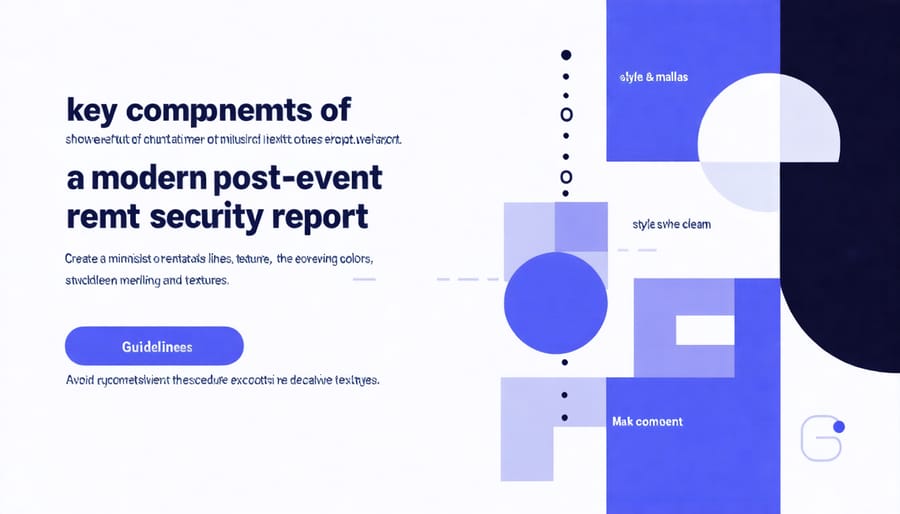Transform post-event reporting from a routine task into a powerful business intelligence tool as Canada’s events industry rebounds. Modern post-event reports serve as critical security documents, compliance records, and strategic planning resources for future gatherings. These comprehensive assessments capture attendance metrics, security incidents, emergency response effectiveness, and stakeholder feedback—essential data points for risk management and operational improvements. Organizations now leverage these reports to demonstrate regulatory compliance, secure insurance coverage, and optimize future event planning in today’s evolving business landscape. By implementing structured post-event reporting protocols, Canadian venues and event organizers create valuable institutional knowledge while meeting heightened safety and security expectations in the post-pandemic environment. This systematic approach to event documentation has become a cornerstone of professional event management, enabling data-driven decisions and continuous improvement in event operations.
The Evolution of Event Security Documentation
Pre vs. Post-Pandemic Security Standards
The COVID-19 pandemic has significantly transformed security documentation requirements for events in Canada. Pre-pandemic security reports primarily focused on crowd control, emergency exits, and basic health and safety measures. Today’s standards demand comprehensive health screening protocols, contact tracing capabilities, and detailed sanitization procedures.
Event organizers now must document vaccination policies, physical distancing measures, and ventilation assessments. Digital documentation has become increasingly important, with many venues requiring electronic record-keeping for quick access and efficient contact tracing. According to the Canadian Centre for Occupational Health and Safety, security reports must now include specific COVID-19 risk mitigation strategies.
Industry expert Sarah Thompson of EventSafe Canada notes, “The evolution of security documentation reflects our new reality. What was once a simple checklist has transformed into a dynamic system that protects attendees while ensuring regulatory compliance.” This shift has prompted many Canadian businesses to adopt integrated digital solutions for more effective security reporting and monitoring.
Digital Integration in Security Reporting
Modern technology has revolutionized security reporting, making it more efficient and accurate than ever before. Digital integration in event management has introduced automated reporting systems that capture real-time data, streamline incident documentation, and ensure comprehensive coverage of security concerns.
Cloud-based reporting platforms now allow security teams to input information directly through mobile devices, attach photos and videos, and generate standardized reports instantly. These digital solutions also facilitate better data analysis, helping organizations identify patterns and potential vulnerabilities across multiple events.
Canadian businesses are increasingly adopting integrated security management systems that combine incident reporting with access control and surveillance data. This integration creates a more complete security picture while reducing administrative burden. The ability to quickly share reports with stakeholders, insurance providers, and law enforcement has become particularly valuable in today’s fast-paced business environment.


Essential Components of Modern Post-Event Reports
Health and Safety Compliance Documentation
The health and safety compliance section of your post-event report serves as a critical record of how well your event adhered to established safety protocols and guidelines. Document all implemented health measures, including screening procedures, sanitization stations, and ventilation systems. Include detailed records of any health-related incidents and how they were handled according to your emergency response plan.
Create a comprehensive checklist that tracks compliance with current provincial and federal health regulations. This should cover physical distancing measures, mask requirements if applicable, and capacity limitations. Note any special accommodations made for vulnerable participants and record the effectiveness of these measures.
Keep detailed documentation of staff training related to health protocols and maintain copies of all relevant certifications. Include vaccination verification procedures if required, while ensuring compliance with privacy laws. Document any communication with local health authorities and their feedback on your safety measures.
This documentation not only demonstrates due diligence but also provides valuable insights for future event planning and risk management. Consider including testimonials from health and safety officers or third-party auditors who evaluated your protocols during the event.
Incident Analysis and Response Times
A thorough analysis of incident response times is crucial for evaluating security effectiveness and identifying areas for improvement. Security teams should document all actions taken during an incident, including initial detection, assessment, deployment of resources, and resolution time. This data helps establish benchmarks for future responses and demonstrates due diligence to stakeholders.
Canadian security expert Sarah Thompson recommends using a standardized response matrix that tracks multiple metrics: “Organizations should measure both the time to detect and time to respond. These metrics provide valuable insights for resource allocation and training needs.”
Key elements to document include:
– Initial alert timestamp
– Security team deployment time
– Communication initiation
– Resolution completion
– Total incident duration
– Resources utilized
Regular review of these metrics enables organizations to optimize their response protocols and maintain compliance with industry standards. Consider implementing automated tracking systems to ensure accurate documentation and facilitate trend analysis.
Contact Tracing Integration
Contact tracing remains a vital component of post-event reporting in today’s environment. Event organizers should maintain detailed digital records of attendee information, including names, contact details, and seating arrangements where applicable. Consider using QR code check-ins or dedicated event apps that automatically log attendance while respecting privacy regulations.
Many Canadian venues now implement integrated systems that combine registration data with on-site tracking. This approach enables quick identification of potential exposure risks while maintaining compliance with provincial health guidelines. Work with local health authorities to establish proper data retention periods and secure storage protocols.
Implement a clear communication plan for notifying attendees about potential exposure risks post-event. Having these systems in place demonstrates due diligence and helps maintain attendee confidence. Consider partnering with specialized event management platforms that offer built-in contact tracing features, making the process more efficient and reliable.
Remember to obtain proper consent for data collection and ensure all information is stored securely in accordance with privacy laws.
Implementing an Effective Reporting System
Digital Tools and Templates
In today’s digital landscape, numerous digital tools for business events and reporting templates can streamline your post-event documentation process. Popular project management platforms like Asana and Monday.com offer customizable event report templates that align with industry standards. For comprehensive reporting, consider using specialized event management software such as EventPro or Ungerboeck, which Canadian event professionals widely trust.
Microsoft Office 365 and Google Workspace provide robust solutions for collaborative report creation. Their cloud-based features enable real-time editing and seamless sharing among team members. Excel and Google Sheets are particularly useful for tracking attendance, budget analysis, and survey data visualization.
For professional presentation, Adobe InDesign and Canva offer polished templates specifically designed for event reports. These tools help create visually appealing documents that effectively communicate event outcomes to stakeholders.
Mobile apps like Evernote and OneNote are excellent for on-site note-taking and photo documentation during the event. Their cross-platform compatibility ensures that all information is readily available when compiling the final report.
For secure data storage and sharing, consider Canadian-compliant cloud solutions like Sync.com or OpenText. These platforms ensure your event data remains protected while meeting national privacy regulations.
Remember to choose tools that integrate well with your existing business systems and offer features that match your reporting requirements.
Staff Training and Compliance
Effective staff training is crucial for maintaining consistent and accurate post-event reporting practices across your organization. Start by developing a comprehensive training program that covers all aspects of your reporting protocols, from data collection to final submission procedures.
Regular training sessions should be conducted to ensure all team members understand their roles and responsibilities in the reporting process. This includes familiarizing staff with required documentation, deadlines, and proper communication channels. Consider implementing a mentorship system where experienced team members guide newer staff through their first few post-event reports.
Canadian event management expert Sarah Thompson recommends creating detailed checklists and templates to streamline the training process: “When staff have clear guidelines and standardized forms to follow, it significantly reduces errors and improves report consistency.”
Establish a verification system to ensure compliance with reporting standards. This can include periodic audits of submitted reports and regular feedback sessions with team members. Document all training activities and maintain records of staff certifications and completions.
Consider incorporating scenario-based training exercises to help staff understand how to handle various reporting situations. This practical approach helps team members develop confidence in their reporting abilities and ensures they’re prepared for different circumstances they might encounter.
Regular refresher courses and updates on new reporting requirements or procedural changes will help maintain high standards and keep your team current with industry best practices.

Legal and Insurance Considerations
Post-event reports play a crucial role in managing legal obligations and protecting your organization from potential liability issues. In Canada, event organizers must comply with various regulations, including provincial health and safety requirements, municipal bylaws, and industry-specific standards.
Insurance providers often require detailed post-event documentation to process claims or maintain coverage. A well-structured report serves as evidence of due diligence and can protect your organization in case of incidents or disputes. Include documentation of any safety measures implemented, incident reports, and compliance with regulatory requirements.
According to the Canadian Association of Special Events Professionals, maintaining comprehensive post-event records has become increasingly important in the post-pandemic landscape. These reports should document adherence to current health and safety protocols, accessibility compliance, and risk management strategies.
Consider consulting with legal professionals to ensure your post-event reporting framework meets all relevant regulatory requirements. Key elements should include:
– Incident documentation and resolution
– Proof of compliance with permits and licenses
– Records of safety protocols followed
– Documentation of insurance requirements met
– Evidence of proper security measures
Keep all supporting documentation, including photographs, witness statements, and official correspondence, for the duration specified by your legal advisors and insurance providers. This practice helps protect your organization and demonstrates professional responsibility in event management.
Post-event reporting continues to evolve as a crucial tool for Canadian businesses, helping organizations adapt and improve their event management strategies. By implementing comprehensive reports, businesses can better track ROI, enhance stakeholder communication, and make data-driven decisions for future events. Industry leaders across Canada have demonstrated that thorough post-event analysis leads to more successful outcomes and stronger business relationships.
Looking ahead, we can expect to see increased integration of digital tools and analytics in post-event reporting, making the process more efficient and insightful. Organizations that embrace these developments while maintaining clear, actionable reporting practices will be better positioned for success in Canada’s dynamic business landscape. Remember that effective post-event reporting isn’t just about documenting what happened—it’s about creating a roadmap for future improvement and growth.
